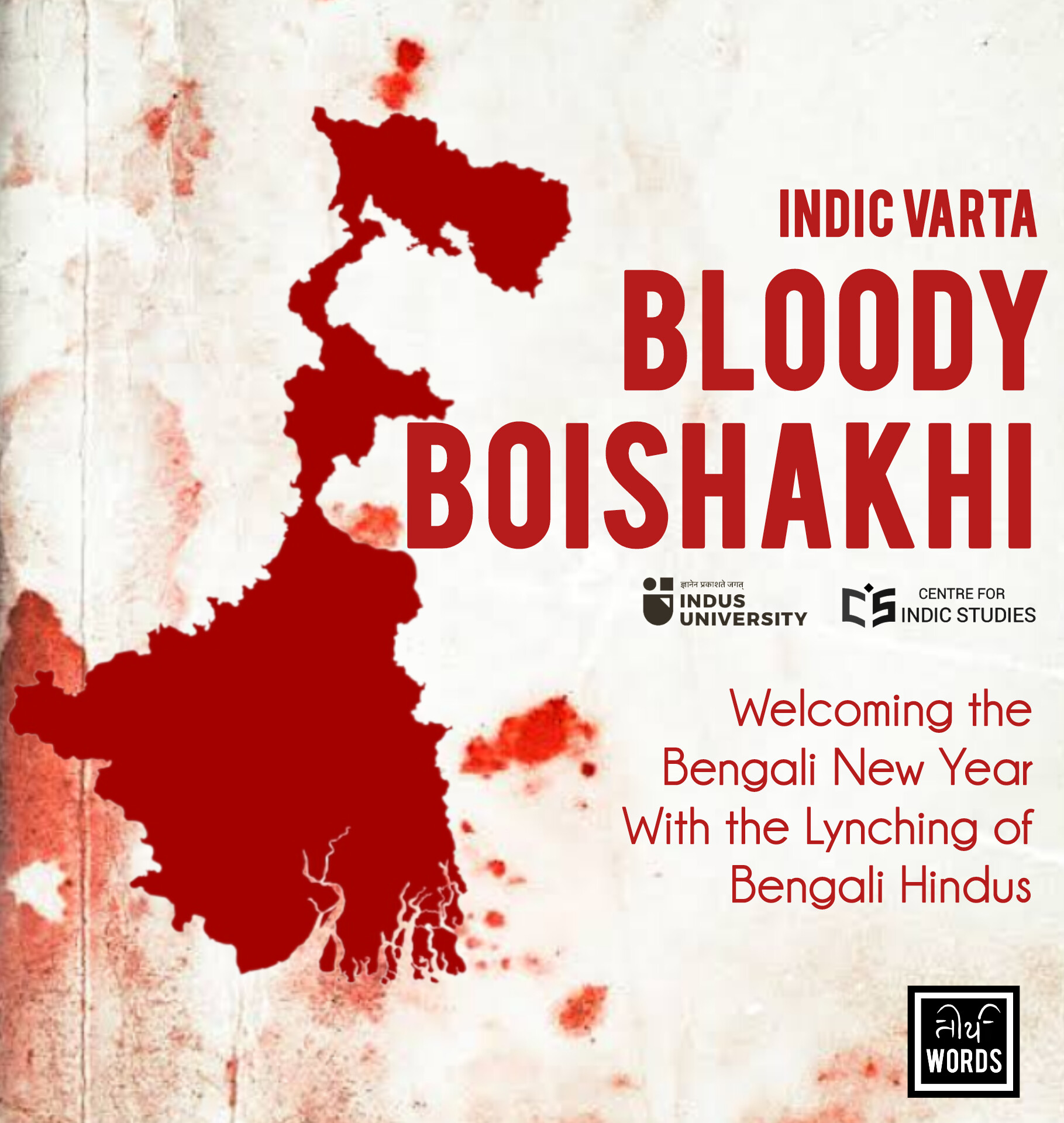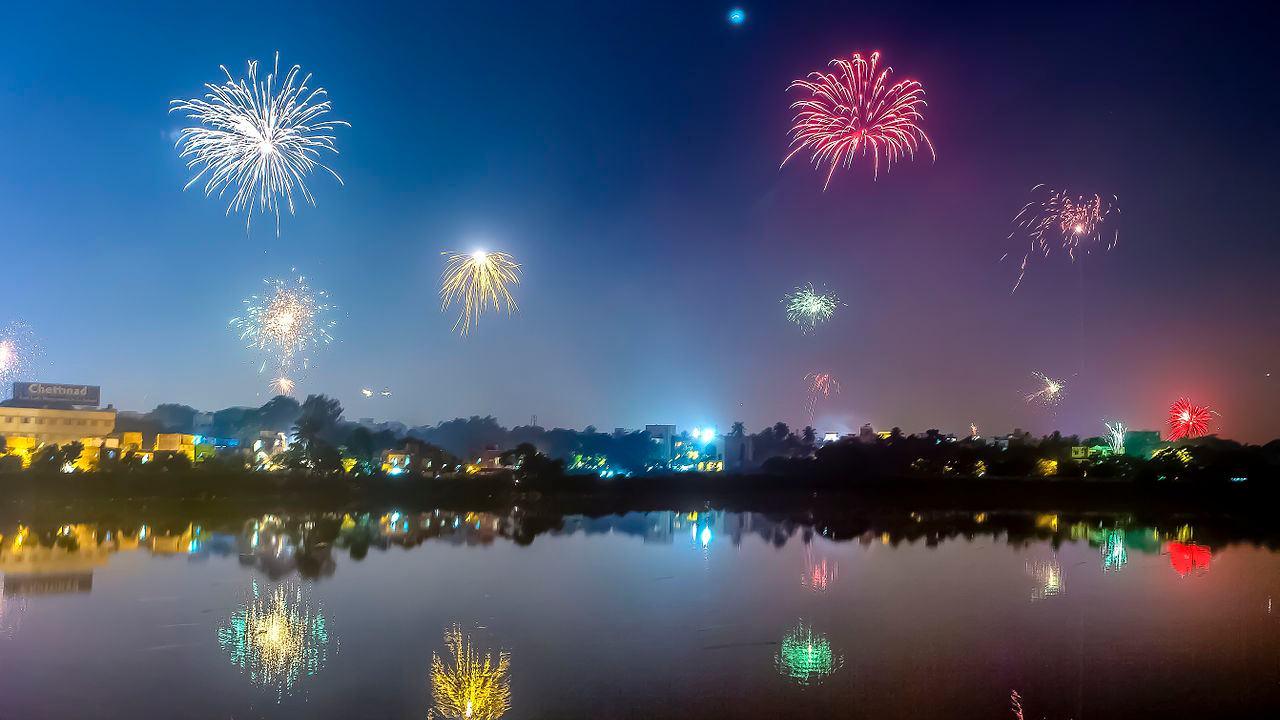- Visitor:300
- Published on: 2025-04-15 08:24 pm
Bloody Boishakhi
The Hindus of Bengal, despite being the majority community in the state, have historically struggled with unity—politically, socially, and culturally. This disunity has often left them vulnerable in the face of communal tensions, demographic shifts, and political neglect. While Bengal’s Hindu population has deep cultural and intellectual roots, their lack of collective organization and assertiveness has frequently hindered them from safeguarding their interests in a politically charged and communally sensitive landscape. One of the major reasons for this fragmentation is ideological diversity. The Bengali Hindu community encompasses a wide range of political leanings—ranging from leftist and liberal ideologies to more nationalist sentiments. This diversity, while reflective of Bengal’s rich intellectual heritage, has also meant that there is little consensus when it comes to safeguarding community interests. For decades, the dominance of left politics promoted class-based identity over religious or cultural identity, leading many Hindus to distance themselves from collective assertions of their own religious or ethnic group. As a result, the idea of Hindu solidarity often took a backseat in Bengal, unlike in other Indian states where community-based unity has had more visible political impact.

It is a bromide imperative that an article ought to be objective. This is not going to be that. This is going to be subjective, this is going to be in first person. This is going to be a piece of opinion that brews from deeply felt anguish and first hand personal experience. However, the article is not merely a lamentation for the mayhem, but rather a chronic aching when you see things getting bad to worse right before your eyes and all you can do is to merely write—the only medium to register my protest. Today, when I was supposed to wish greetings of the Bengali new year to my near and dear ones, my throat goes dry to see what is happening to innocent and peaceful Hindu folks in Murshidabad where a group of Islamic fanatics, incited by the clergies and backed by the incumbent government, are raging havoc. Murshidabad is the neighbouring district of my hometown and much of the claims I make in this article are borne by subjective experience. Before I articulate, let me foreground the reason first.
The Ongoing Murshidabad Riots
The ongoing Murshidabad riots in April, 2025, which you may have already watched on television or read on newspapers or portals, have once again exposed the deep-seated communal tensions in West Bengal and the apathy of the state government towards the plight of the Hindu community. Sparked by protests against the Waqf Amendment Act (2025) the situation rapidly escalated into violent clashes, resulting in the tragic deaths of three individuals, including a Hindu father and son, Hargobind Das and Chandan Das, who were reportedly hacked to death by a mob in Samserganj. The violence also led to injuries to over ten individuals and the arrest of more than 200 people.
The Waqf Amendment Act (2025), as most of you already know, introduced significant changes to the administration of Waqf properties, aiming to enhance transparency and accountability. However, it faced strong opposition from certain sections of the Muslim community, particularly in West Bengal. The Chief Minister of the state, Mamata Banerjee, declared that the Act would not be implemented in the state, wooing the Muslim community even as violence erupted in Muslim-majority districts like Murshidabad. The state's response to the violence has been inadequate. Despite the deployment of additional police forces and the suspension of internet services to curb the unrest, the situation deteriorated to the point where the Calcutta High Court had to intervene, ordering the deployment of Central Armed Police Forces to restore order. This intervention certainly highlights the state's failure to deescalate the situation and protect its citizens effectively. The main opposition party, Bharatiya Janata Party (BJP), has accused the state government of inaction and alleged that the violence was a result of the administration's reluctance to act against those resorting to violence in the name of protests. BJP leaders have claimed that the Chief Minister's office was complicit in stoking widespread discontent over the Waqf Amendment Act, thereby contributing to the unrest.
The Murshidabad riots have once again reignited the concerns about the safety and security of the Hindu community in West Bengal. The targeted attacks and the state's perceived failure to protect its citizens have led to accusations of minority appeasement and a lack of impartial governance. These events underscore the need for a balanced approach that ensures the protection of all communities and upholds the rule of law. However, I assure you that this is not the first instance of such ‘politically permitted’ riots. Let me resurface before you the 2016-17 riots of Dhulagarh and Basirhat.
The Dhulagarh and Basirhat Riots of 2016-17
The Dhulagarh and Basirhat riots in West Bengal were flashpoints of communal tension that had drawn national attention between 2016-17, both for the violence itself and the government's alleged inaction. In December, 2016, the Dhulagarh area near Howrah witnessed severe communal clashes that reportedly began during a religious procession. According to various well-documented media reports and local testimonies, the Muslim mobs attacked Hindu homes and businesses, looting and setting them ablaze. The Hindu residents, who were attacked and managed to get away by sheer luck, claimed that these onslaughts were orchestrated and targeted, with some alleging that the police stood by passively or arrived too late to prevent the violence. Videos, verified by several agencies, circulated on social media by affected victims and others thereby showed burning houses, injured individuals, and distraught families seeking help. Similarly, the Basirhat riots in July, 2017, erupted after a controversial social media post, but what followed was days of chaos and destruction. Hindu families were reported to have been forcibly displaced, temples vandalized, and shops set on fire by angry mobs. Victims in both instances claimed they were singled out for their ‘Hindu’ identity which included ‘Dalits’ as well, and many of the narratives emerging from the ground accused the state machinery of deliberate indifference.
What intensified the public anger and the primetime television debates was the perception that the West Bengal government, led by Chief Minister Mamata Banerjee, did little to stop the violence or bring the perpetrators to justice. It was certain that the administration’s response was not just slow but also complicit in nature, allegedly driven by a policy of minority appeasement aimed at preserving the party’s ‘Muslim vote-bank’. Multiple ‘right-wing’ political commentators and opposition leaders accused the state government of suppressing media coverage of the riots, detaining journalists who attempted to report on the incidents, and even allegedly intimidating victims from speaking out. The lack of a transparent probe or significant arrests in both riots only fuelled further suspicions that justice was being deliberately stalled. This perception of bias and selective silence from the state added to a growing narrative of Hindu victimization, particularly in areas where demographic shifts have intensified communal friction. While the state government maintained that law and order were under control and dismissed the accusations as politically motivated, even the blind can point to the pattern of recurring communal unrest where Hindus bore the brunt of mob attacks. Allegations of lynching, displacement, and destruction of Hindu-owned property were echoed by numerous civil society groups and opposition parties. The political and communal dimensions of these riots have since become part of a larger debate about religious polarization, demographic change, and vote-bank politics in Bengal. Regardless of the political leanings, the failure to prevent the violence and protect citizens during the Dhulagarh and Basirhat riots raises serious questions about governance, accountability, and the impartiality of state institutions in maintaining communal harmony.
Appease Muslims, Secure Vote-Bank
Mamata Banerjee, the Chief Minister of West Bengal and leader of the Trinamool Congress (TMC), has often faced accusations of practicing what critics call "Muslim appeasement politics" since she came to power in 2011. These allegations stem from a series of decisions, public statements, and administrative actions that can only be perceived as skewed in favour of the Muslim community, often at the expense of secular governance or the interests of other communities, particularly Hindus. One of the earliest points of contention was her government's move to provide stipends and financial assistance to imams and muezzins across the state. While framed as a welfare measure to support clerics from economically weaker backgrounds, it is discernable that this was a clear attempt to court the Muslim vote-bank, given that no similar financial aid was extended to religious leaders of other communities. The Calcutta High Court eventually struck down this scheme in 2013, stating it was unconstitutional and violated the secular fabric of the state.
Another area of concern has been the handling of communal tensions and riots. In incidents such as the Dhulagarh riots (2016), Basirhat unrest (2017), and more recently the Murshidabad violence (2025), the state government has been accused of downplaying or even suppressing the communal nature of these riots. In many of these cases, it was suggested that the government avoided naming or arresting individuals from the minority community, fearing political backlash or loss of electoral support. Moreover, Mamata’s strong opposition to the Citizenship Amendment Act (CAA), the National Register of Citizens (NRC), and the more recent Waqf Amendment Act has further justified the claims of her appeasement tactics. While she presents these stances as part of her broader commitment to secularism and constitutional values, an unbiased person might argue that these positions are rooted in a desire to safeguard the loyalty of a key voter base. In fact, in the case of the Waqf Amendment Act, her government refused to implement the legislation in West Bengal, a move seen as controversial given the growing allegations of land encroachments and irregularities related to waqf properties. Does not this defiance to the amended act, which was constitutionally gazetted after being passed by both the houses, merit sedition?
Not just defiance to the legal jurisdiction, even her political rhetoric deserves criticism. She has been known to make frequent appeals to the Muslim community during election campaigns to take up united stands which can only be interpreted as communal invocations to violence using religious slogans and symbols. This has led the Election Commission to issue warnings for violating the Model Code of Conduct. Her presence at events organized by Islamic organizations coupled by her silence on instances of radicalization or communal aggression has also been viewed as signs of biased governance. While Mamata Banerjee claims to represent inclusive politics and governance for all, her track record has led us to believe that her policies disproportionately favour the Muslim community. This perceived tilt, combined with her government's handling of communal violence and selective welfare schemes, continues to fuel the narrative of Muslim appeasement in West Bengal politics.
The ‘Hindu’ Problem
The Hindus of Bengal, despite being the majority community in the state, have historically struggled with unity—politically, socially, and culturally. This disunity has often left them vulnerable in the face of communal tensions, demographic shifts, and political neglect. While Bengal’s Hindu population has deep cultural and intellectual roots, their lack of collective organization and assertiveness has frequently hindered them from safeguarding their interests in a politically charged and communally sensitive landscape. One of the major reasons for this fragmentation is ideological diversity. The Bengali Hindu community encompasses a wide range of political leanings—ranging from leftist and liberal ideologies to more nationalist sentiments. This diversity, while reflective of Bengal’s rich intellectual heritage, has also meant that there is little consensus when it comes to safeguarding community interests. For decades, the dominance of left politics promoted class-based identity over religious or cultural identity, leading many Hindus to distance themselves from collective assertions of their own religious or ethnic group. As a result, the idea of Hindu solidarity often took a backseat in Bengal, unlike in other Indian states where community-based unity has had more visible political impact.
Another contributing factor is the urban-rural divide. Urban Hindus in cities like Kolkata, with access to education and media, often prioritize cosmopolitan and secular values. In contrast, rural Hindus—especially those living in border districts like Cooch Behar, Murshidabad, and North 24 Parganas—face ground realities such as illegal immigration, demographic changes, and occasional communal violence. Yet, there is minimal effort to bridge the gap between urban intellectual discourse and rural anxieties. This disconnect has weakened any collective response to the challenges the community faces. In addition, caste and regional identities within Bengali Hindus also play a divisive role. While caste-based discrimination is not as overt in Bengal as in some other parts of India, caste loyalties often translate into political choices. The ‘Dalit’ Hindus, for example, have at times felt alienated from upper-caste leadership and narratives. This lack of inclusiveness makes it difficult to foster a unified Hindu identity. Moreover, the influx of refugees from East Pakistan (now Bangladesh) post-Partition created a division between ‘ghoṭi’ (native) and ‘bāṅgāl’ (refugee) Hindus—a cultural rift that still subtly persists in certain social and political spaces.
Finally, the lack of assertive leadership has left the Hindu community without a strong voice. In contrast to the consolidated political mobilization seen among some minority communities, Hindu leaders in Bengal have often been divided among competing parties and ideologies. Without unified leadership, efforts to raise concerns about temple desecrations, religious conversions, or riots often get diluted or politicized. In essence, the Hindus of Bengal remain fragmented—ideologically, culturally, and politically. This disunity not only affects their ability to respond to threats or injustices but also prevents them from influencing policy or political discourse in a meaningful way. Until there is a conscious effort to rise above internal divisions and build a cohesive identity, the community will continue to face challenges without a strong, united front.
When Beshyas are More Ethical than the Buddhijivis
The phrase ‘Bengali Buddhijivi’ has
become a cliché. Therefore, I propose to address them with another
epithet: the ‘Buddhijivi
Beshyas’ (which literally translates to ‘intellectual prostitutes’). Kolkata
has historically produced two clans in abundance: the intellectuals and the prostitutes.
Nowadays, the both might be hailed synonymous, unless the latter is a more
respectful profession. It is at this juncture that I must caution the reader at this
juncture that the beshyas of Sonagachi have
more ethical standards than the petty intellectuals of the city— so much so
that you might address the former in terms of the latter and it would be an
insult to them. The term is not merely a sharp, provocative
critique aimed at a certain class of Bengali intellectuals whose hypocrisy,
selective activism, and moral bankruptcy have become glaring in today’s
socio-political landscape, but also a testimony of the collapse from the
greatness that our intellectuals once possessed. Once respected torchbearers of
truth, reason, and resistance, many of these self-proclaimed progressives have
now become apologists for political convenience, motivated more by personal
gain and ideological bias than any commitment to justice or truth. In contrast,
one might argue, the prostitutes of Sonagachi—the red-light district of
Kolkata—live with more dignity, consistency, and ethical clarity than these
so-called intellectuals who sell their conscience for applause, grants, or
proximity to power. Prostitutes in Sonagachi do not pretend. They do not
camouflage their trade with flowery language or moral superiority. They survive
by selling their bodies, not their souls. There is a brutal honesty in what
they do. Their work, though stigmatized, is based on consent, clarity, and
survival. They do not claim to be society's moral compass. On the other hand,
the modern Bengali buddhijivi
claims to stand for the voiceless and marginalized, while routinely ignoring or
distorting truths that do not align with their political loyalties. They will
take to the streets over an event in Gujarat or Uttar Pradesh, but remain
conspicuously silent when temples are attacked in West Bengal, when Hindus are
lynched in Basirhat, Dhulagarh, or Murshidabad, or when free speech is crushed
by regimes they align with ideologically. These buddhijivis cherry-pick their causes with
surgical precision. If an incident benefits their narrative, it’s amplified. If
not, it’s conveniently ignored. This selective outrage isn’t just hypocrisy,
it’s betrayal— betrayal of the very values they pretend to uphold! In contrast,
the women of Sonagachi do not make claims of higher purpose. They do not preach
morality while practicing opportunism. Many of them, despite facing daily
exploitation and violence, still show solidarity and humanity that put the
intellectual class to shame. They fight for their children’s education,
organize for their rights, and often support each other in ways that reveal
deeper ethics than the performative solidarity of panel-room intellectuals.
What is even more disturbing is how
many of these buddhijivis
use their intellectual status to whitewash violence and justify inaction.
Whether it’s turning a blind eye to communal violence against Hindus in Bengal
or supporting repressive laws when passed by governments they like, their
loyalty lies not with truth, but with ideology. They would rather be
fashionable than be factual. They write glowing columns, sign petitions, attend
book launches—all while ignoring the blood in their backyard. In the end, the
comparison is not meant to demean sex workers—it is meant to highlight the
moral decay of an elite class that once prided itself on conscience and
courage. Today, the buddhijivi
beshya is not a slur—it is a tragic reality. When conscience is for
sale, and silence is bought with comfort, it is not the women of Sonagachi who
need redemption—it is the intellectuals of Bengal.
- 150 min read
- 9
- 0










